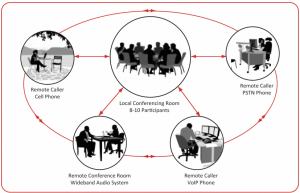Home > BLOG CENTER > A LOOK AT AUDIO BASICS
Home > BLOG CENTER > A LOOK AT AUDIO BASICS
Audio visual integrators spend decades learning the complexities of audio processing and room acoustics. While it is not required that you develop that same level of expertise, you’ll benefit from a basic understanding of audio concepts. This introduction to room considerations and audio terminology will help you plan and invest in a conferencing solution that will create successful, productive meetings with any remote participant.
ROOM ACOUSTICS AND USE
Room acoustics refer to how sound behaves based on certain characteristics of the room such as surfaces and size. A room with a glass wall or with a number of hard, reflective surfaces will change how the audio sounds. It may reverberate or sound hollow, reducing intelligibility. Wall treatments and audio processing equipment can combat quality issues created by hard surfaces and glass walls.
Larger rooms require more loudspeakers to fill the room with sound so all participants can hear. They also require more microphones to pick up all participants’ voices so they can be heard by remote participants. In some very large rooms, it may be necessary to also reinforce local audio through loudspeakers so that people in the back of the room can hear. Generally speaking, the larger the meeting room, the more requirements there are that must be met to deliver a natural experience.
Another important consideration is the purpose of the room. Will it be used strictly for teleconferencing or will there be additional audio sources from DVD players, video conferencing units, and even PCs? If your conference room needs to accommodate multiple remote parties at the same time, it is important to ensure all audio is fully integrated so all participants can hear each other clearly regardless of whether they are connecting by cell phone, video conference, landline, or PC.

Conference systems need to integrate all types of endpoints and allow all participants to communicate clearly with each other.
AUDIO CONCEPTS
ACOUSTIC ECHO CANCELLATION (AEC).
When audio from the remote caller is picked up by the microphones in your conference room and sent back to the caller, it creates echo. Echo is extremely distracting and creates listener fatigue—if the participants are even willing to hang in that long. Echo is eliminated using a technique called acoustic echo cancellation. Basically, a conferencing system with acoustic echo cancellation has the ability to compare audio signals being sent and received and eliminate duplicate signals or echo. This is a critical feature for any conferencing system.
AMBIENT NOISE.
Ambient noise is the background or room noise that occurs in every space. These noises compete with voice audio and can make it difficult to understand what is being said. Noise cancellation technology reduces ambient noise so that only voice audio is transmitted to remote meeting participants instead of the hum of air conditioning, the sound of pages being turned, coughing, or other such background noises.
AUDIO BANDWIDTH.
Bandwidth in the audio world refers to the frequency range of the audio signal rather than speed or size. Wideband audio is 7kHz, which provides fuller, more natural sound. By contrast, narrowband audio, or that of a standard telephone, is 3.3kHz.
DIGITAL SIGNAL PROCESSING (DSP).
DSP refers to various techniques used to enhance the clarity and intelligibility of audio before it is transmitted to the remote party. This is particularly important when you have a wide mix of audio sources.
40088 41166info@meeteasy.com.hk
3/F,Building#10, Jiu Xiang Ling Industrial Zone,Xili
Nanshan District, Shenzhen, 518055, China